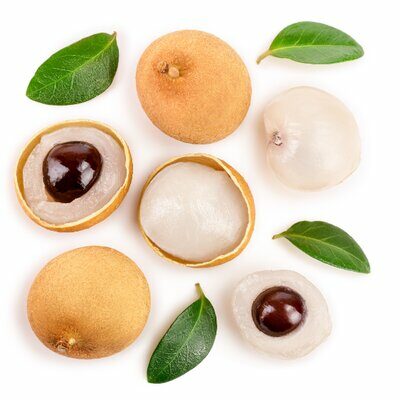
Longan
also known as Dimocarpus longan
What is a Longan?
Longan is a tropical fruit belonging to the soapberry family. It is related to the lychee and rambutan, and is quite similar to the former.
Each fruit has a seed at the center. The name itself comes from Cantonese, and literally translates to ‘dragon eye’, in reference to the flesh of the fruit.
Some popular Asian fruits include:
- Pomelo
- Jackfruit
- Wax Apple
- Lychee
- Rambutan
- Durian
- Asian Pear
- Mangosteen
- Longan
- Guava
- Lotus Fruit
Origin of longan
This fruit originated in southern China, and can be traced back to the provinces of Kwangtung, Kwangsi, Schezwan, and Fukien. The first records of this fruit come from the Han dynasty around 200 BC. The emperor at the time had this fruit planted in the palace gardens. They eventually flourished throughout the country. However, it took a while for this fruit to spread to other parts of the world, and it was only in the 18th century that it was introduced to other countries.
Nutrition
Nutritional profile for this fruit (1 fruit):

Additionally, longan is rich in micronutrients such as potassium, magnesium, phosphorous, and vitamin C. It was used in traditional Chinese medicine for promoting blood flow, soothing nerves, and insomnia. The flesh contains bioactive compounds such as phenolic acids, flavonoids, and polysaccharides. These give the fruit anti-inflammatory, antiviral, antioxidant, and anti-bacterial properties. Regular consumption of this fruit may also help in combating cancer. However, excessive consumption may also lead to inflammation of the gut, ulcers, and gum bleeding.
Commercial production
This fruit grows best in sandy soils and a temperate climate. It requires both wet and dry spells, and a cool period, though it is sensitive to freezing. They are harvested when they achieve full maturity, and immediately kept in a cool environment. They may be preserved for long periods if frozen. This fruit is best stored in the fridge, where it can last for up to 2 weeks.
The main longan producing countries of the world include China, Thailand, Taiwan, Malaysia, Indonesia, Cambodia, Laos, Vietnam, India, Sri Lanka, the Philippines, Australia, South Africa, Mauritius, the United States, and Bangladesh.
Longan recipes
This fruit is extensively used in Asia to prepare a variety of desserts and sweet dishes. Here are a few recipes to try:
- Smoothie
- Cheesecake
- Tong Shui
- Lemon Fruit Cookies
- Coconut Rice Pudding
- Red Date Longan Tea
- Black Rice Pudding
- Roast Chicken Curry
- Blue Longan Agar Agar Jelly
- Air Mata Kucing
- Cheng Tng
FDA regulations
The FDA describes all fresh fruits as raw agricultural commodity and strictly regulates all aspects its growing, harvesting, packing, and storage. However, longans are not specifically mentioned in this list.
References
Prakash Chandra Tripathi, Longan (Dimocarpus longan Lour.), Krishi, Indian Council of Agricultural Research (ICAR), https://krishi.icar.gov.in/jspui/bitstream/123456789/58786/1/10-Longan.pdf
Longan Fruit Farming and Cultivation Practices, AgriFarming, https://www.agrifarming.in/longan-fruit-farming-and-cultivation-practices
Huang, Guan-Jhong et al. “Antioxidant and Anti-Inflammatory Properties of Longan (Dimocarpus longan Lour.) Pericarp.” Evidence-based complementary and alternative medicine : eCAM vol. 2012 (2012): 709483. doi:10.1155/2012/709483, https://www.ncbi.nlm.nih.gov/pmc/articles/PMC3433710/
